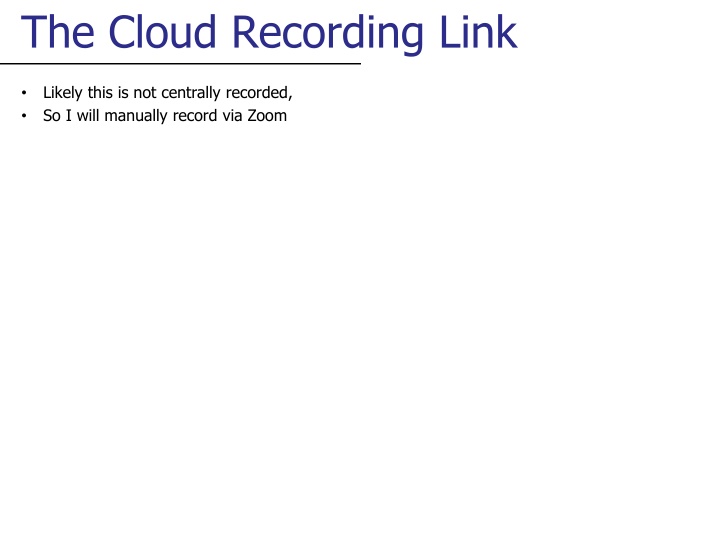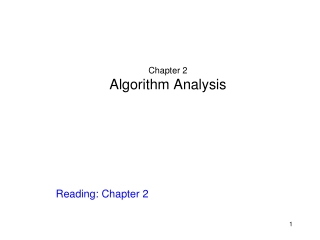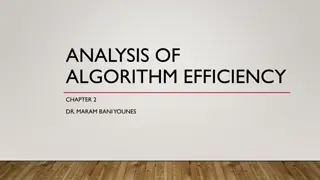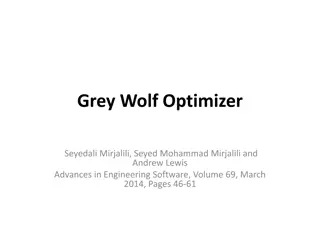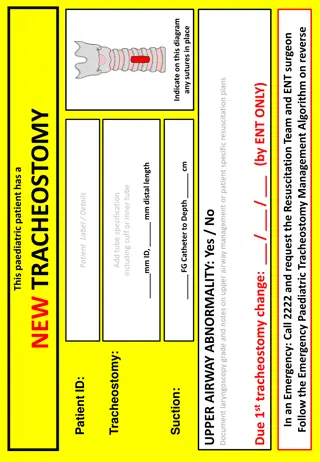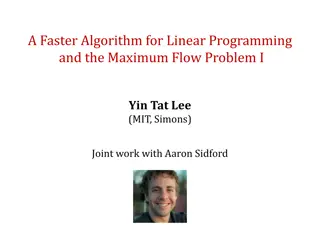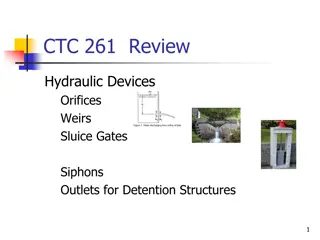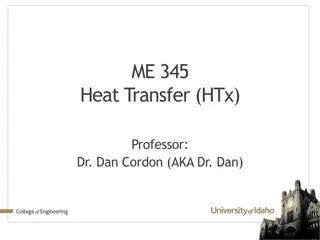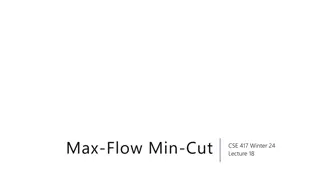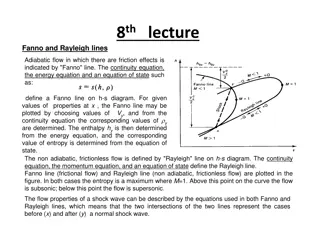Optimizing Flow Networks through Push-Relabel Algorithm
This overview delves into optimizing flow networks through the Push-Relabel Algorithm. It covers key concepts including Ford-Fulkerson method variations, implementation strategies, and residual graphs. Dive into augmenting path finding methods like "Any augmenting path" and "Fattest Path" to enhance flow efficiency.
Download Presentation

Please find below an Image/Link to download the presentation.
The content on the website is provided AS IS for your information and personal use only. It may not be sold, licensed, or shared on other websites without obtaining consent from the author.If you encounter any issues during the download, it is possible that the publisher has removed the file from their server.
You are allowed to download the files provided on this website for personal or commercial use, subject to the condition that they are used lawfully. All files are the property of their respective owners.
The content on the website is provided AS IS for your information and personal use only. It may not be sold, licensed, or shared on other websites without obtaining consent from the author.
E N D
Presentation Transcript
The Cloud Recording Link Likely this is not centrally recorded, So I will manually record via Zoom
v0.5: Seth Gilbert v1.7: Steven Halim CS4234 Optimiz(s)ation Algorithms L12 Push-Relabel Max-Flow Algorithm What if we don t fixate our thoughts towards finding even better augmenting paths iteratively
Roadmap Push-Relabel Algorithm a. Recap about Ford-Fulkerson and its variations b. Introducing Push-Relabel Algorithm c. Analysis of Push-Relabel Algorithm: O(n2 m) d. Implementation note
Recap: The Max-Flow Problem Given a Flow Network A directed graph G = (V, E) with n vertices and m edges With a distinguished source vertex s and sink vertex t With (integer) capacities on edges Find an st maximum flow on G that satisfies: Capacity constraints: f(e) c(e) Flow conservation constraints: f(ein v) = f(ev out) Animation
Recap: Ford-Fulkerson (1/2) 1. Build residual graph R 2. While augmenting path P in R 1. Let b be the capacity of the bottleneck edge in P 2. Add path p with value b to flow 3. Update the residual graph R (forward+backward edges) Build flow incrementally Max of this iteration p with b is a legal flow Example of the residual network of the original input graph after sending a 2-units flow through path 0 2 3 4 with edge 2 3 with capacity 2 as the bottleneck edge
Recap: Ford-Fulkerson (2/2) Ford-Fulkerson method has several implementations on its augmenting path finding strategies: 1. "Any augmenting path" (use DFS): O(m2 U) 2. "Fattest Path" (use Dijkstra s): O(m2log n log F) 3. Capacity Scaling ("Divide & Conquer"): O(m2log U) 4. Shortest Path/Edmonds-Karp (use BFS): O(m2n) Discussed in details 5. Level Graph/Dinic s (use BFS++): O(m n2) Discussed in overview Notice where the power of 2 resides
Roadmap Push-Relabel Algorithm a. Recap about Ford-Fulkerson and its variations b. Introducing Push-Relabel Algorithm c. Analysis of Push-Relabel Algorithm: O(n2 m) d. Implementation note
Research on Max Flow https://en.wikipedia.org/wiki/Maximum_flow_problem#Algorithms But Push-Relabel was removed from CLRS 3rd 4thedition
A New Idea A Paradigm Shift What if we think out of the box and not force our self to always pick legal flow iteratively, as with Ford-Fulkerson methods with various augmenting path finding strategies Such flow may not be feasible, so we call it pre-flow Idea of Push-Relabel: 1. Push as much flow as possible from the source vertex s Invariant: No s t path in R While vertex with unbalanced flow (flow in > flow out) 2. a) Calculate excess flow in that vertex (flow in - flow out) b) Push some excess flow on an edge in residual graph R Eventual excess that does not form the final max flow will return to the source vertex s Idea Summary: This Push-Relabel algorithm thus starts from possibly illegal flows and iteratively make the flows legal We will see later that when the flow is feasible we have max flow
Push-Relabel Preview (1/3) This algorithm is not yet implemented in VisuAlgo And this one below is not the full version, so we go manual The sum of capacities of all edges that goes out from source scan be the upper bound of max flow value excess = 5 excess = 4
Push-Relabel Preview (2/3) excess = 5-2 = 3 excess = 4+2 = 6 excess = 3 excess = 5 excess = 6-5 = 1
Push-Relabel Preview (3/3) excess = 3+1 = 4 excess = 5 excess = 1-1 = 0
Definitions Pre-flow: Assignment flow f(u, v) 0 to every edge (u, v) E such that: 1. (u, v) E, f(u, v) c(u, v) // that is, we always satisfy the capacity constraints 2. u V-{t}, zf(z, u) w f(u, w) // that is, flow-in is flow-out excess(u) = z f(z, u) - w f(u, w) Abbreviated as x(u) e(u) in other books but e and E are too similar If u V-{s, t}, x(u) = 0, we say the pre-flow is feasible and that is our goal: Push flow (that arrives from source vertex s) around until all x(u) = 0
Minor Issue: Cycle Pushing flow in circle/cycle is problematic Try this (A pushes 7 to B, B pushes 7 to C and C pushes 7 back to A): B ?/8 x(A) = 7 ?/1 7/7 A t s ?/8 ?/8 ?/1 C
Another Idea Cycle is an issue not just in this case Push-Relabel algorithm but also in other various SSSP algorithms, so can we make it acyclic? Yes, assign a height h(u) for every vertex u V and then use an additional rule so that we can only push a flow from higher vertices to lower vertices s x(A) = 7 This graph is now acyclic, a DAG , verify! 7/7 ?/8 ?/8 h(s)=5 A h(B)=2 B h(A)=3 Cannot push flow here ?/8 ?/1 C ?/1 t But what if C is unbalanced (x(C) > 0) but its valid outgoing edge (C, t) is already saturated, i.e., f(C, t) = c(C, t)? h(C)=1 h(t)=0
Basic Push-Relabel Algorithm (1/3) Input: 1. Flow graph G = (V, E) with n vertices and m edges 2. Source s and sink t 3. Capacities c The algorithm (line 1-3 are initializations) 1. u V, h(u) = 0 // heights start at 0 2. h(s) = n // source is high, at height n = |V| 3. u V : (s, u) E, then f(s, u) = c(s, u) // source vertex s pushes as much flow // as possible in order to kick start // the algorithm
Basic Push-Relabel Algorithm (2/3) 4. while f is not feasible // u s.t. x(u) > 0 5. r(u, v) = c(u, v) - f(u, v) + f(v, u) // R 6. if u V-{s, t} and v V where x(u) > 0 and // vertex u has excess flow r(u, v) > 0 and // (u, v) has capacity left h(u) > h(v) // vertex u is higher than v 7. then b = min(x(u), r(u, v)) // bottleneck 8. f(u, v) += b // push b flow, u to v 9. else choose v : x(v) > 0 // w: r(v, w) > 0 10. h(v)++ // raise height by 1, a.k.a. // the relabel operation if we cannot // push any flow (name is historical)
Basic Push-Relabel Algorithm (3/3) As its name implies, this algorithm has two operations: Push Relabel Line 7-8 Line 9-10 There are two possible scenarios in line 7 Simple, take a vertex with excess flow but which cannot execute line 7-8 and just raise its height by +1 b = r(u, v), so edge (u, v) in R is at capacity after this saturating push; vertex u becomes balanced only if r(u, v) is also x(u) The choice of name of this operation is historical b != r(u, v) but b = x(u), i.e., all excess flow is pushed by this non-saturating push and vertex u becomes balanced
Full Execution (1/12) s=0, t=4, Initial flow graph with n=5 vertices and m=7 edges h(1) = 0 x(1) = 0 1 0/5 0/3 0/6 h(0) = 5 0 0/2 4 0/4 0/2 h(4) = 0 3 2 0/5 h(3) = 0 x(3) = 0 h(2) = 0 x(2) = 0
Full Execution (2/12) s=0, t=4, Residual graph post initialization, Vertex 0 pushes 5+4 units to vertex 1 and 2, both are saturating pushes Set Unbalanced = {1, 2} h(1) = 0 x(1) = 5 0 1 0 3 6 5 h(0) = 5 0 0 2 4 0 4 0 2 h(4) = 0 3 2 5 0 0 h(3) = 0 x(3) = 0 h(2) = 0 x(2) = 4
Full Execution (3/12) Unbalanced = {1, 2}, vertex 1 cannot push anything, relabel 1 Set Unbalanced = {2, 1} h(1) = 1 x(1) = 5 0 1 0 3 6 5 h(0) = 5 0 0 2 4 0 4 0 2 h(4) = 0 3 2 5 0 0 h(3) = 0 x(3) = 0 h(2) = 0 x(2) = 4
Full Execution (4/12) Unbalanced = {2, 1}, vertex 2 cannot push anything, relabel 2 Set Unbalanced = {1, 2} h(1) = 1 x(1) = 5 0 1 0 3 6 5 h(0) = 5 0 0 2 4 0 4 0 2 h(4) = 0 3 2 5 0 0 h(3) = 0 x(3) = 0 h(2) = 1 x(2) = 4
Full Execution (5/12) Unbalanced = {1, 2}, vertex 1 pushes 5 units to vertex 4 A non-saturating push Set Unbalanced = {2} x(1) = 0 Every non-saturating push will make the excess of the origin vertex back to 0 h(1) = 1 5 1 0 3 1 5 h(0) = 5 0 0 2 4 0 4 0 2 h(4) = 0 3 2 5 0 0 h(3) = 0 x(3) = 0 h(2) = 1 x(2) = 4
Full Execution (6/12) Unbalanced = {2}, vertex 2 pushes 4 units to vertex 3 A non-saturating push Set Unbalanced = {3} h(1) = 1 x(1) = 0 5 1 0 3 1 5 h(0) = 5 0 0 2 4 0 4 0 2 h(4) = 0 3 2 1 4 0 h(3) = 0 x(3) = 4 h(2) = 1 x(2) = 0
Full Execution (7/12) Unbalanced = {3}, vertex 3 cannot push anything, relabel 3 Set Unbalanced = {3} h(1) = 1 x(1) = 0 5 1 0 3 1 5 h(0) = 5 0 0 2 4 0 4 0 2 h(4) = 0 3 2 1 4 0 h(3) = 1 x(3) = 4 h(2) = 1 x(2) = 0
Full Execution (8/12) Unbalanced = {3}, vertex 3 pushes 2 units to vertex 4 A saturating push Set Unbalanced = {3} h(1) = 1 x(1) = 0 5 1 0 3 1 5 h(0) = 5 0 0 2 4 0 4 0 0 h(4) = 0 3 2 1 4 2 A saturating push rarely make the excess of the origin vertex balanced h(3) = 1 x(3) = 2 h(2) = 1 x(2) = 0
Full Execution (9/12) Unbalanced = {3}, vertex 3 cannot push anything, relabel 3 Set Unbalanced = {3} h(1) = 1 x(1) = 0 5 1 0 3 1 5 h(0) = 5 0 0 2 4 0 4 0 0 h(4) = 0 3 2 1 4 2 h(3) = 2 x(3) = 2 h(2) = 1 x(2) = 0
Full Execution (10/12) Unbalanced = {3}, vertex 3 pushes 2 unit to vertex 1 A non-saturating push Set Unbalanced = {1} h(1) = 1 x(1) = 2 5 1 0 1 1 5 h(0) = 5 0 0 2 4 2 4 0 0 h(4) = 0 3 2 1 4 2 h(3) = 2 x(3) = 0 h(2) = 1 x(2) = 0
Full Execution (11/12) Unbalanced = {1}, vertex 1 pushes 1 unit to vertex 4 A saturating push Set Unbalanced = {1} h(1) = 1 x(1) = 1 6 1 0 1 0 5 h(0) = 5 0 0 2 4 2 4 0 0 h(4) = 0 3 2 1 4 2 h(3) = 2 x(3) = 0 h(2) = 1 x(2) = 0
Full Execution (12/12) Unbalanced = {1}, vertex 1 cannot push anything and will pushes the last 1 unit excess around cycle 1 2 3, h(1) = 1 x(1) = 1 implementations do this part in a more clever way Some 6 1 0 1 0 5 h(0) = 5 0 0 2 4 2 4 0 0 h(4) = 0 3 2 1 4 2 h(3) = 2 x(3) = 0 h(2) = 1 x(2) = 0 relabeling the 3 vertices until either {1 or 2} is higher than the source (h(0)=5) to return the unused 1 unit back to source 0
Roadmap Push-Relabel Algorithm a. Recap about Ford-Fulkerson and its variations b. Introducing Push-Relabel Algorithm c. Analysis of Push-Relabel Algorithm: O(n2 m) d. Implementation note
Analysis Plan 1. Max height < 2n 2. # of relabel operations (2n)*n 2n2 3. # of saturating pushes 2mn 4. # of non-saturating pushes 2n2+[2mn]*(2n) 4n2m This is the largest, so it bounds the runtime of Push-Relabel Max height # of relabels # of saturating pushes 5. Algorithm terminates after O(n2m) operations and upon termination, u V-{s,t} has x(u) = 0, i.e., the flow is feasible 6. As there is no s t path left in R, this feasible flow is maximum (proven by Max-Flow/Min-Cut theorem)
A1: Max height < 2n Lemma: If vertex i has excess flow, then there is a path from i to source s in residual network R This is clearly logical: How else can vertex i get excess flow except from s? But let s prove it Let set A be the set of vertices that can reach back the source vertex s on R We will show that vertex i that has excess A That is, as i is an arbitrary vertex in R, the proof will show that all vertices with excess flow are in set A
zAx(z) 0 // excess flow, if any, cannot be negative z A x(z) = z A ( u f(u, z)- v f(z, v)) // by definition of excess = z A u f(u, z)- z A v f(z, v) // expansion = z A u A f(u, z)+ z A u A f(u, z) // split u to in A/not - z A v A f(z, v) - z A v A f(z, v) // split v to in A/not Cancel each other as u, z, v can be any vertex A Flow-in Flow-out = z A u A f(u, z) - z A v A f(z, v) =0, no flow from u A to z A by definition, otherwise z A 0, by definition of flow 0 z A x(z) = 0, or in another word i : x(i) 0, i A
Corollaries (1/3) Push-Relabel algorithm maintains Steepness condition, i.e., for all edges (u, v) R, we have h(u) h(v)+1 h(1) = 1 x(1) = 2 5 1 0 3 1 5 h(0) = 5 0 0 2 4 0 4 0 0 h(4) = 0 3 2 1 4 2 h(3) = 2 x(3) = 0 h(2) = 1 x(2) = 0 Corollary: If there is a path from u to v in R, then h(u) h(v)+n-1 Longest simple path is at most n-1 edges
Corollaries (2/3) At all steps, there is no path from s to t in R Proof by Contradiction If there were a path, then h(s) h(t)+n-1 But h(s)=n, h(t)=0, and their height never changes n 0+n-1 n n-1 ?? contradiction So once flow f becomes feasible due to Push- Relabel operations, then flow f that disconnects s from t in R, is a Min Cut = Max Flow (due to Max Flow/Min Cut Theorem)
Corollaries (3/3) At all steps, u V, h(u) 2n-1 Proof by Contradiction Let u be a vertex and consider relabel from h(u) = 2n-1 to h(u) = 2n Relabel occurs only when x(u) > 0 (and can t push) So we know that there is a path from u to s in R h(u) h(s)+n-1 2n-1 Of at most n-1 edges After relabel, h(u) = 2n > 2n-1, but h(u) 2n-1?? Contradiction, so u V, h(u) 2n-1
A2: # of relabels (2n)*n 2n2 The proof is immediate from A1 and # of vertices n Initially for any vertex u except u = s, h(u) = 0 From A1, we know that h(u) 2n-1 So each vertex has at most 2n-1 relabel operations There are n vertices in the flow graph So # of relabel operations is clearly (2n)*n 2n2
A3: # of saturating pushes 2mn Proof: Consider an arbitrary edge (u, v); How many saturating pushes can it have? r(u, v) = Z u v Then edge (u, v) can not push anything until a back flow happens that push back flow from v back to u h(v)=x h(u)=x+1 After a saturating push u v r(u, v) = 0 u v That back flow can only happen when h(v) is relabeled to x+2 h(v)=x h(v)=x+2 h(u)=x+1 r(v, u) = Z # of saturating pushes for an arbitrary edge (u, v) 1+(2n-2)/2 n First relabel Max Height (A1)-1 divided by 2 relabels per saturating push 2m edges in R, so up to 2mn saturating pushes
A4: # of non-saturating pushes 2n2+[2mn]*(2n) We have now bounded the number of relabel and saturating pushes, but Push-Relabel algorithm may have to do a certain number of non-saturating pushes Can we bound this too? Yes, using idea of Potential argument, like in Physics (also in CS3230 amortised analysis topic) Show that each non-saturating push makes progress Define: Energy (f) of flow f = u: x(u)>0 h(u) That is, sum of heights of vertices with positive excess Initially (f) = 0 and after first relabel (f) = 1 But at all times (f) 0
Charging up Potential Energy (f) On a relabel, (f) increases by +1 because as we relabel arbitrary vertex u that have x(u)>0, its height h(u) increases by +1, thus (f) increases by +1 On a saturating push, (f) increases by 2n because a saturating push from edge u to v does not change the height of both u and v, BUT before such push, x(v) = 0 and now x(v) > 0 (and contributes to (f)), but as h(v) 2n, (f) can only increase by up to 2n Total increase of (f) due to up to 2n2 relabels (A2) and 2mn saturating pushes (A3) 2n2*1 + 2mn*2n 2n2 + 4n2m
Discharging Potential Energy (f) On non-saturating push from u to v, we have: Before: x(u) > 0 // thus we need to push x(u) < r(u, v) // as it is non-saturating h(u) > h(v)// that s why we can push After: x(u) = 0 // vertex u is 'relieved' x(v) > 0 // vertex v gets the excess r(u, v) > 0 // remember, this is non-saturating h(u) > h(v) // nothing changes here
The Net Effect to (f) The change in (f): Increase h(v) // as x(v) > 0 now and v can be t with h(t)=0 Decrease = h(u) // as x(u) = 0 now (f) h(v) - h(u) -1 // h(u) is taller than h(v) (f) decreases by at least 1 on every non-saturating push Since (f) 0 at all time, and it is initially 0 and increases by 2n2+4n2m, there are 2n2+4n2m non-saturating pushes at maximum
Finally. Corollary: Push-Relabel algorithm will terminate in O(n2 m) bounded by the max possible non-saturating pushes as by then u V-{s,t}, x(u) = 0 and therefore no more pushing or relabeling is needed When Push-Relabel algorithm terminates, it finds a legal flow f that disconnects source s and sink t in R, so it finds max flow in O(n2 m) time
Roadmap Push-Relabel Algorithm a. Recap about Ford-Fulkerson and its variations b. Introducing Push-Relabel Algorithm c. Analysis of Push-Relabel Algorithm: O(n2 m) d. Implementation note
Implementation How to efficiently implement Push-Relabel algorithm? 1. Maintain good data structure for residual graph R (so that we have O(1) updates per push operation) 2. Maintain a linked list of unbalanced vertices, i.e., those with x(u) > 0 (so that we have O(1) per push) 3. For each vertex, maintain a circular list of adjacent vertices so that we can push excess flow in a fair manner 1. In each step, we start with the first unbalanced vertex in the list. Examine edges in order until we find one with lower height. 2. Remember where you stop and restart from there next time. 3. If none found, do relabel operation instead. This is just a sketch there are other minor technicalities There is an O(n3) version of Push-Relabel algorithm https://en.wikipedia.org/wiki/Push%E2%80%93relabel_maximum_flow_algorithm#Active_node_selection_rules
Sample Implementation See available sources in the Internet e.g., refer to Stanford s ICPC team for O(n3) Push- Relabel implementation https://github.com/jaehyunp/stanfordacm/blob/master/code/PushRelabel.cc
Roadmap/Summary Push-Relabel Algorithm a. Recap about Ford-Fulkerson and its variations b. Introducing Push-Relabel Algorithm c. Analysis of Push-Relabel Algorithm: O(n2 m) d. Implementation note All the best for your Final PS: there will be some simple Push-Relabel questions as MCQs in the final
